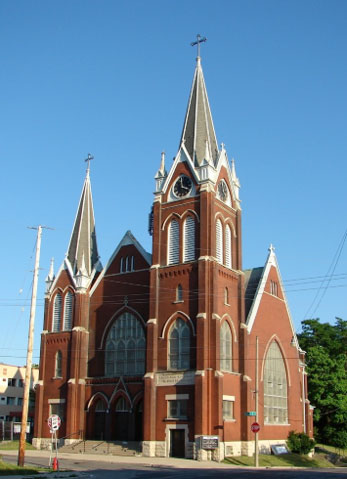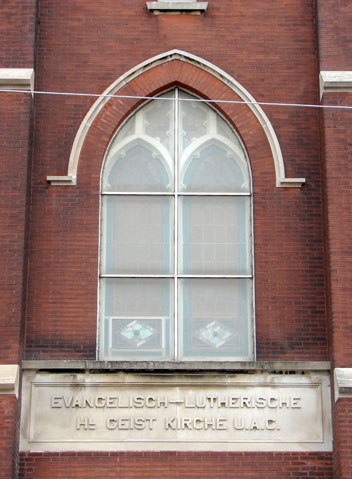42. Holy Ghost Lutheran, 1905
547 West Concordia Avenue
Architects: Leiser and Holst
A small group of German Lutherans founded Holy Ghost congregation in 1876, building a church of modest size on the current property in 1880. Later that year, the congregation acquired a church building at 5th and Wells Streets that had been the home of Trinity Lutheran. Trinity congregation had just finished building its large brick church, rendering surplus its older wooden church. Holy Ghost congregation bought the older building for $300, including the altar, pulpit, and pews. The church was then dismantled and reconstructed more than two miles to the north, on the Holy Ghost property at 6th Street and Concordia Avenue. At that time, the property was part of the rural settlement known as Williamsburg, which was not annexed by the City of Milwaukee until 1891.
By the first decade of the twentieth century, with the church in need of major repairs, the congregation decided to erect a new house of worship rather than face the mounting cost of maintaining the old one. The cornerstone of the present church was laid in August of 1905, with dedication of the completed building one year later. The dedication ceremonies included two services in German and one in English. Regularly scheduled services in English began on Armistice Day (November 11) of 1924, while German-language services continued into the early 1960s.
The steeple that tops the northwest tower of Holy Ghost Lutheran reaches a height of 120 feet above the sidewalk. Although this is considerably shorter than the steeples of many of the city’s nineteenth century Gothic Revival churches, Holy Ghost is one of the last churches in this style to have a tower and steeple of such height. It is also one of the last churches built in Milwaukee to have a clock on its bell tower. There are two dozen churches with tower clocks in the city, but only two of these were constructed after 1905: St. Augustine Catholic in the Bay View neighborhood, built in 1908, and St. Adalbert’s Catholic on the South Side, built in 1930.
Inside the church, the main floor and the U-shaped balcony provide seating for about 700 people. Most of the worship space is covered by a single cross vault (a pointed-arch vault in both the north-south and east-west directions) that forms the high ceiling. Gothic Revival churches with vaulted plaster ceilings typically have a series of vaults supported by columns, giving the interior a strong axial orientation from the rear of the worship space to the front. Holy Ghost Lutheran is unusual in that the single cross vault is more like a dome covering the square worship space. Even though the pews are arranged in straight rows with a central aisle, rather than a semi-circular arrangement as in some Protestant churches of the period, the proportions of the room and the form of the ceiling provide a greater sense of unity to the seated congregation.
Alterations to the church in the 1920s included replacement of the original gaslights with electric lighting. The conversion to electric lighting happened later than in most of the city’s older churches, as the neighborhood was still at the northern edge of urban development prior to the 1920s.
Sources:
Bockhaus, G. A., et al. The Holy Ghost Story: Seventy-fifth Anniversary, Holy Ghost Lutheran Church. Holy Ghost Lutheran Church, c. 1951.

